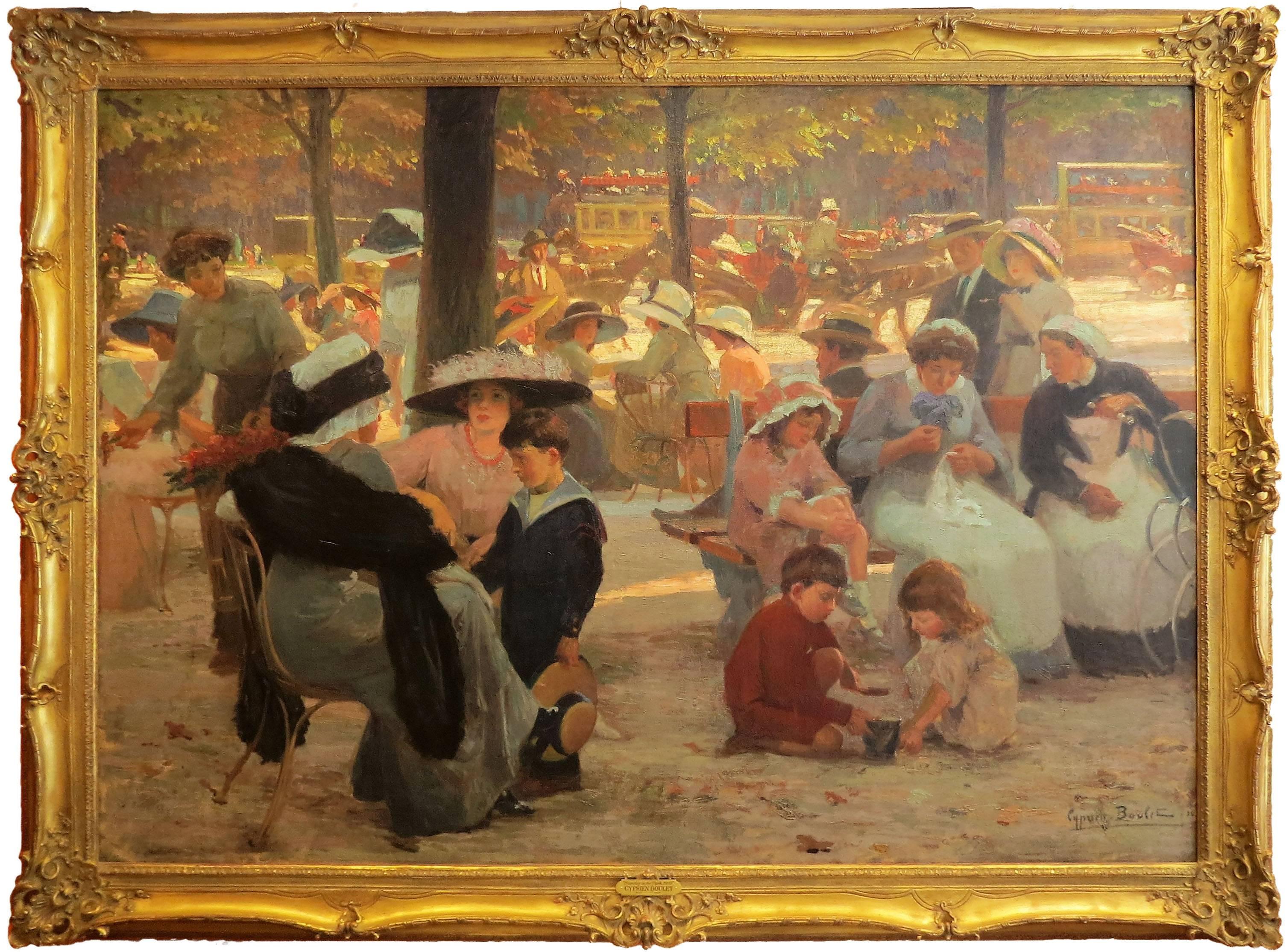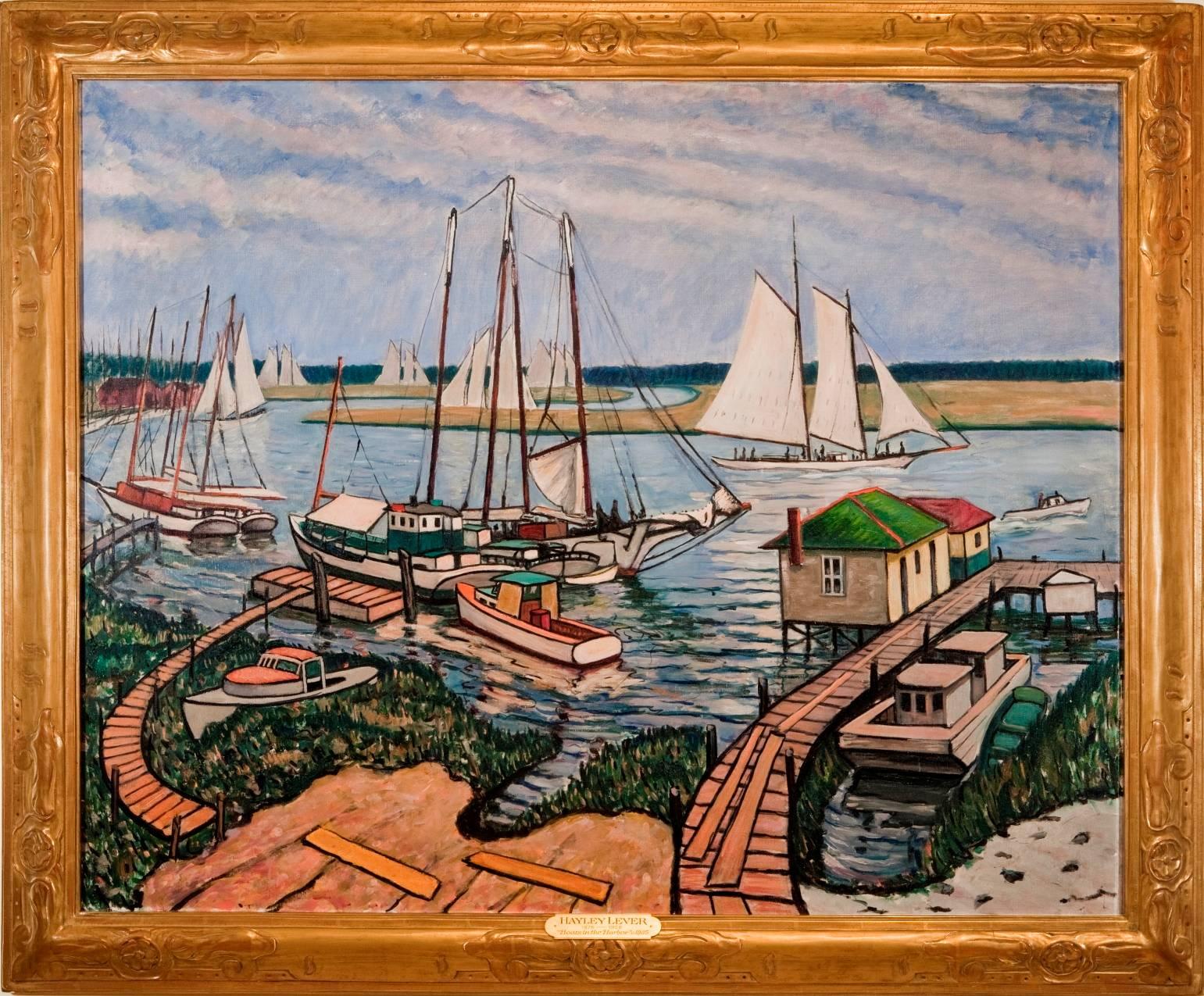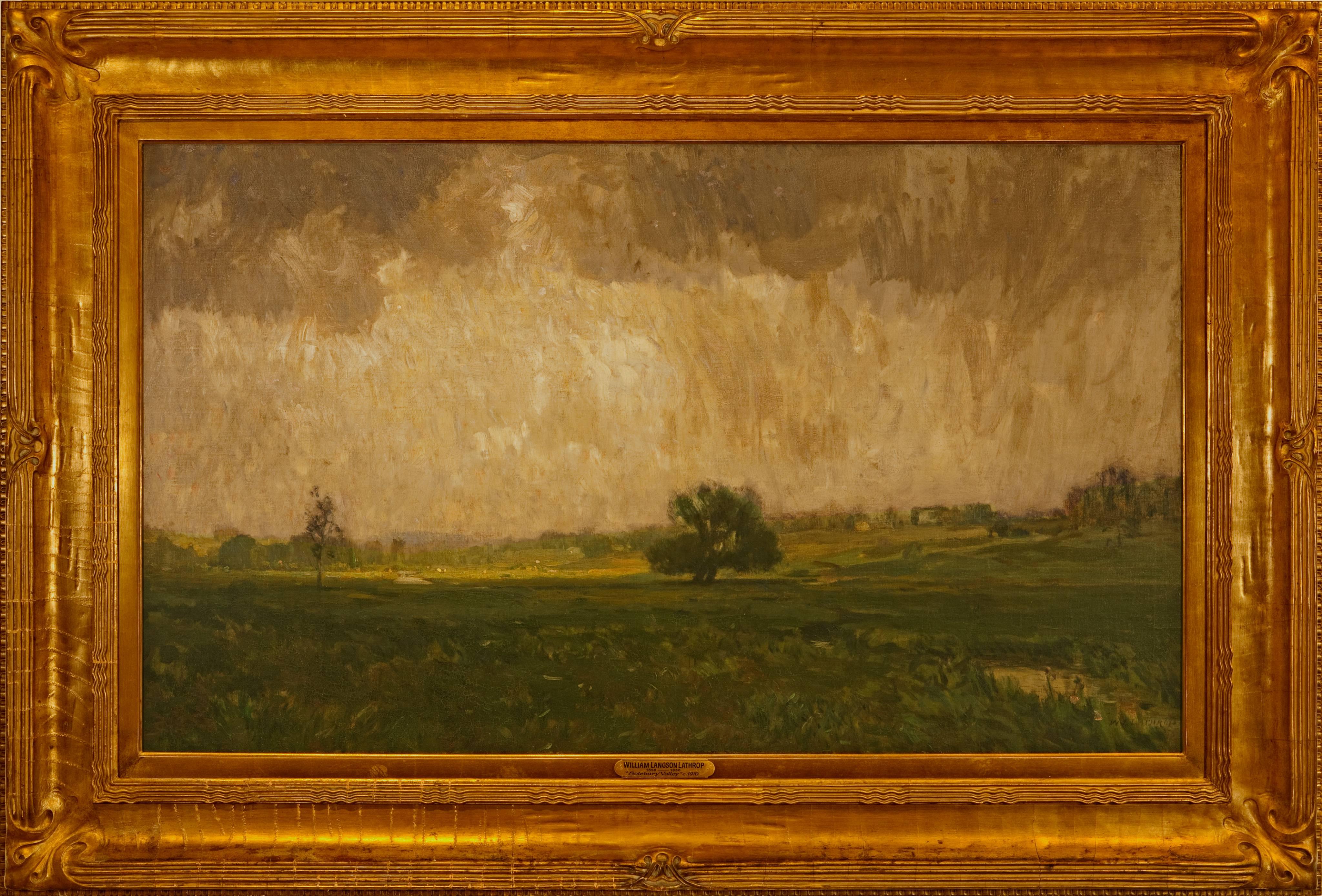Items Similar to Crossing the Common French 19thC art figurative windmill landscape oil painting
Want more images or videos?
Request additional images or videos from the seller
1 of 12
Georges MichelCrossing the Common French 19thC art figurative windmill landscape oil paintingCirca 1835
Circa 1835
About the Item
This superb French 19th century figurative landscape oil painting with excellent provenance is by noted French artist Georges Michel. Painted circa 1835 it is entitled verso Crossing the Common. The painting depicts an expansive flat landscape with a windmill and trees to the right. In the foreground a mother, in a red dress and child are walking along a path towards the windmill and away from the viewer and artist. The foreground is bathed in light under a blustery looking sky. Michel always painted within a small area limited to the surroundings of Paris. His preferred locations were Montmartre, where he was inspired by the famous windmills, the plains of Saint-Denis, the villages ofVaugirard, Grenelle, Montsouris, Romainville and Le Pré-Saint-Gervais so this is likely to be one of those locations, perhaps the plains of Sant-Denis. Michel developed a very personal vision, in which light and treatment of the sky and space became his principal concern. His paintings became more unified compositionally, with vast expanses of landscape and wide perspectives under stormy skies. The windmills are often the sole accents punctuating the compositions. After 1830 he was at the peak of his talent. His style became even more lyrical and visionary, his brushstrokes broader and his paint thicker. This painting is an excellent example of all of the above.
Provenance: The collection of James S. Forbes Esq. His sale, May 23 1874, Christie's lot 119
Bought by Thomas Agnew & Sons for George Salting Esq.Sale,
Christie's, Sir Thomas Devitt, 16 May 1924, lot 139
Derrick Warden Milligan (d. 1974)
Thence by family descent
Various labels verso.
Condition. Oil on paper laid on canvas, image size 22 inches by 18 inches, in good condition.
Frame. Housed in an ornate gilt frame, 30 inches by 26 inches, in good condition.
Georges Michel (1763-1843). Michel was born in in Paris. He came from a humble background, his father being an employee at the market of Les Halles. At an early age, Michel worked on a farm in the Saint-Denis region, north of Paris, where he first developed his interest in the countryside. In 1775, he was apprenticed to a mediocre history painter, but he preferred to sketch outdoors. A colonel of the Hussars engaged him in his regiment, garrisoned in Normandy, and arranged for him to take further lessons. Michel remained there for more than a year, after which he returned to Paris. Later in 1798, Michel left for Switzerland, and also visited Germany. The art dealer Jean-Baptiste-Pierre Le Brun authorized Michel to copy the seventeenth century Dutch paintings that were in his shop, and was, in a way, very responsible for the artist’s further artistic development. In 1791 Michel debuted at the Salon, where he continued to exhibit regularly. Nevertheless, critics ignored Michel, considering his works too similar to those of the Dutch masters. Around 1800, Michel was employed by the Musée du Louvre to restore their Flemish and Dutch paintings, and it was in this capacity that he developed a true understanding of the technique of his predecessors. In 1808, he decided to set up a studio and give lessons, but he stopped teaching the following year. In 1813 he opened a shop adjacent to his studio and sold furniture and paintings. He exhibited for the last time at the Salon of 1814. After the death in 1820 of the last surviving of his eight children, he left Paris to stay for one year in Picardy. After his return, he began to live a reclusive life and gradually withdrew from the art world. Because of his self-imposed artistic isolation, Michel had to rely solely on the patronage of the Baron d’Ivry, who purchased almost his entire output until 1830, when the two men had a falling out over political differences. Michel always painted within a small area limited to the surroundings of Paris. He commented that ‘whoever cannot paint within an area of four leagues is but an unskilled artist who seeks the mandrake and will only ever find a void.” His preferred locations were Montmartre, where he was inspired by the famous windmills, the plains of Saint-Denis, the villages ofVaugirard, Grenelle, Montsouris, Romainville and Le Pré-Saint-Gervais. His small plein air studies were often drawings heightened with watercolor wash, which were then used as preliminaries for paintings worked up in the studio. His career can be divided into three phases. The first, until circa 1808, includes the period of his collaboration with Jean-Louis Demarne and Jacques-François Swebach, artists who often executed the staffage of his landscapes. Later he developed a more personal vision, in which light and treatment of the sky and space became his principal concern. His paintings became more unified compositionally, with vast expanses of landscape and wide perspectives under stormy skies. The windmills are often the sole accents punctuating the compositions. After 1830 he was at the peak of his talent. His style became even more lyrical and visionary, his brushstrokes broader and his paint thicker. He reinforced the dramatic tension by accentuating the heaviness of the skies and the contrasts of light and dark. Michel had little interest in fame, and with the exception of a few early paintings, his works are unsigned. Michel meant that the quality of the painting should speak to the beholder, and not the signature. He never achieved success during his lifetime and in 1841, two years before his death, the contents of his studio, consisting of more than 1000 studies and 2000 drawings, were put up at auction. The Barbizon painter Charles Jacques acquired several of his works, and other artists from this group, like Jules Dupré, were much inspired by Michel. His importance is more as a precursor of the works of the Barbizon school, while his own oeuvre has not yet been given the full attention that it deserves.
Selected Museum Collections:
Amiens; Baltimore, Walters Art Museum; Bayeux; Beauvais, Musée départemental de l’Oise; Béziers; Bordeaux, Musée des Beaux-Arts; Boston, Museum of Fine Arts; Brest; Buffalo, NY, Albright-Knox Art Gallery; Carpentras; Chicago, Art Institute of Chicago; Cleveland Museum of Art; Dijon, Musée Magnin; Hanover; The Hague, Museum Mesdag; Lille, Musée des Beaux-Arts; London, Courtauld Institute; London, National Gallery; Lyon, Musée des Beaux-Arts; Madrid, Thyssen-bornemisza Museum; Nantes; New York, Metropolitan Museum of Art; Paris, Musée du Louvre; Pontoise; Portland Art Museum; Rennes, Musée des Beaux-Arts; St. Petersburg, Hermitage; State College, PA, Palmer Museum of Art; Strasbourg; Valenciennes, Musée des Beaux-Arts..
- Creator:Georges Michel (1763-1843, French)
- Creation Year:Circa 1835
- Dimensions:Height: 26 in (66.04 cm)Width: 30 in (76.2 cm)Depth: 2 in (5.08 cm)
- Medium:
- Movement & Style:
- Period:
- Condition:
- Gallery Location:London, GB
- Reference Number:1stDibs: LU853114375122
About the Seller
5.0
Platinum Seller
These expertly vetted sellers are 1stDibs' most experienced sellers and are rated highest by our customers.
1stDibs seller since 2018
402 sales on 1stDibs
Typical response time: <1 hour
- ShippingRetrieving quote...Ships From: London, United Kingdom
- Return PolicyA return for this item may be initiated within 14 days of delivery.
More From This SellerView All
- Celebrations at Marienplatz, Munich French 1900 art city landscape oil paintingBy Jacques Emile BlancheLocated in London, GBThis superb French Impressionist city landscape oil painting is attributed to Jacques Emile Blanche and has his characteristic brushwork. It was painted circa 1900 and portrays a civ...Category
Early 1900s Impressionist Landscape Paintings
MaterialsOil
- Landscape with Cattle and Sheep - British Victorian art Pastoral oil paintingBy William Mark FisherLocated in London, GBThis lovely British Victorian Impressionist pastoral landscape oil painting is by prolific exhibitor William Mark Fisher. Known as a B...Category
19th Century Impressionist Landscape Paintings
MaterialsOil
- Moorland Stream Balquhidder - Scottish Impressionist 1923 exhib oil paintingBy Joseph Morris HendersonLocated in London, GBThis superb, large Scottish Impressionist exhibited landscape oil painting is by noted artist Joseph Morris Henderson. It was painted in 1923 and exhibited at the Glasgow Institute o...Category
1920s Impressionist Landscape Paintings
MaterialsOil
- Over the Sea, Sennen - British Victorian coastal portrait oil painting CornwallBy John WhiteLocated in London, GBThis superb Victorian exhibited oil painting is a masterpiece of British Newlyn School art by John White. The painting depicts a mother and child overlooking the sea on a hilltop. Th...Category
19th Century Impressionist Landscape Paintings
MaterialsOil
- Glimpse of the Sea - Scottish 1915 art Impressionist landscape oil paintingBy Sir Charles James Lawton WingateLocated in London, GBA superb landscape oil painting on canvas by Sir James Lawton Wingate, President of The Royal Scottish Academy. This painting shows a windswept Scottish landscape and a "glimpse of t...Category
1910s Impressionist Landscape Paintings
MaterialsOil
- A Shady Pool - Scottish Edwardian Impressionist art landscape oil paintingLocated in London, GBThis lovely Scottish Edwardian Impressionist exhibited landscape oil painting is by noted artist George Whitton Johnstone. Painted in 1901 it was exhibited at the Royal Scottish Acad...Category
Early 1900s Impressionist Landscape Paintings
MaterialsOil
You May Also Like
- 'Agay, le château et le Sémaphore'. Oil on canvas. Signed.By Armand GuillauminLocated in Paris, FR'Agay, le château et le Sémaphore'. Oil on canvas. +/- 1922 Signed lower right Measurements : 60 x 73 cm. This painting will be recorded in the second volume of the Catalogue Raisonn...Category
1920s Impressionist Landscape Paintings
MaterialsOil
- "Sunday in the Park, 1910"By Cyprien Eugène BouletLocated in Lambertville, NJSigned Lower Right Cyprien-Eugène Boulet (1877 - 1927)Category
Early 20th Century Impressionist Landscape Paintings
MaterialsCanvas, Oil
- "Boats in the Harbor"By Hayley LeverLocated in Lambertville, NJOriginal Period Frame Hayley Lever (1876 - 1958) Hayley Lever's exceptional career path took him from the shores of his native Australia to those of England, and then the United S...Category
1930s Impressionist Landscape Paintings
MaterialsCanvas, Oil
- "Alley Fiends"By John R. GrabachLocated in Lambertville, NJJim’s of Lambertville is proud to offer this artwork by: John R. Grabach (1886 - 1981) John Grabach was a highly regarded New Jersey artist, teacher, and author of the classic text...Category
1930s American Impressionist Landscape Paintings
MaterialsCanvas, Oil
- "Forest Strongholds"By John F. CarlsonLocated in Lambertville, NJSigned lower right. Complemented by a hand carved and gilt frame. Exhibited at the National Academy of Design, 1928Category
20th Century American Impressionist Landscape Paintings
MaterialsCanvas, Oil
- "Solebury Valley"By William Langson LathropLocated in Lambertville, NJSigned lower right. Complemented by a period frame. William L. Lathrop (1859-1938) Deemed “Father of the New Hope Art Colony”, William Langson Lathrop was born in Warren, Illinois. He was largely self-taught, having only studied briefly with William Merritt Chase in 1887, at the Art Students League. Lathrop first moved east in the early 1880s, and took a job at the Photoengraving Company in New York City. While there, he befriended a fellow employee, Henry B. Snell. The two men became lifelong friends and ultimately, both would be considered central figures among the New Hope Art Colony. Lathrop's early years as an artist were ones of continuing struggle. His efforts to break through in the New York art scene seemed futile, so he scraped enough money together to travel to Europe with Henry Snell in1888. There he met and married an English girl, Annie Burt. Upon returning to New York, he tried his hand at etching, making tools from old saw blades...Category
1910s American Impressionist Landscape Paintings
MaterialsCanvas, Oil
Recently Viewed
View AllMore Ways To Browse
Antique Art Sale
Paris Art Dealers
Antique Painting Unsigned
Antique Shop Drawing
Vision Antique
Antique Oil Painting Red
Antique Frames Lot
Swiss Style Paper Art
Musee De Louvre
Antique Studio Light
Art Auction Sale
Saint George Painting
Ornate Framed Landscape Art
Montmartre Oil Painting
Art Four Antiques
Montmartre Frame
Oil Paintings Of Montmartre
The Windmill




